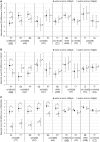Association Between Variants in Arsenic (+3 Oxidation State) Methyltranserase (AS3MT) and Urinary Metabolites of Inorganic Arsenic: Role of Exposure Level
- PMID: 27370415
- PMCID: PMC5808745
- DOI: 10.1093/toxsci/kfw112
Association Between Variants in Arsenic (+3 Oxidation State) Methyltranserase (AS3MT) and Urinary Metabolites of Inorganic Arsenic: Role of Exposure Level
Abstract
Variants in AS3MT, the gene encoding arsenic (+3 oxidation state) methyltranserase, have been shown to influence patterns of inorganic arsenic (iAs) metabolism. Several studies have suggested that capacity to metabolize iAs may vary depending on levels of iAs exposure. However, it is not known whether the influence of variants in AS3MT on iAs metabolism also vary by level of exposure. We investigated, in a population of Mexican adults exposed to drinking water As, whether associations between 7 candidate variants in AS3MT and urinary iAs metabolites were consistent with prior studies, and whether these associations varied depending on the level of exposure. Overall, associations between urinary iAs metabolites and AS3MT variants were consistent with the literature. Referent genotypes, defined as the genotype previously associated with a higher percentage of urinary dimethylated As (DMAs%), were associated with significant increases in the DMAs% and ratio of DMAs to monomethylated As (MAs), and significant reductions in MAs% and iAs%. For 3 variants, associations between genotypes and iAs metabolism were significantly stronger among subjects exposed to water As >50 versus ≤50 ppb (water As X genotype interaction P < .05). In contrast, for 1 variant (rs17881215), associations were significantly stronger at exposures ≤50 ppb. Results suggest that iAs exposure may influence the extent to which several AS3MT variants affect iAs metabolism. The variants most strongly associated with iAs metabolism-and perhaps with susceptibility to iAs-associated disease-may vary in settings with exposure level.
Keywords: Arsenic (+3 oxidation state) methyltranserase polymorphism; arsenic; arsenic metabolites; drinking water; methylation capacity.; urinary arsenic.
© The Author 2016. Published by Oxford University Press on behalf of the Society of Toxicology. All rights reserved. For Permissions, please e-mail: journals.permissions@oup.com.
Figures


References
-
- Agusa T., Iwata H., Fujihara J., Kunito T., Takeshita H., Minh T. B., Trang P. T., Viet P. H., Tanabe S. (2009). Genetic polymorphisms in AS3MT and arsenic metabolism in residents of the Red River Delta, Vietnam. Toxicol. Appl. Pharmacol. 236, 131–141. - PubMed
-
- Ahsan H., Chen Y., Kibriya M. G., Slavkovich V., Parvez F., Jasmine F., Gamble M. V., Graziano J. H. (2007). Arsenic metabolism, genetic susceptibility, and risk of premalignant skin lesions in Bangladesh. Cancer Epidemiol. Biomarkers Prev. 16, 1270–1278. - PubMed
-
- Antonelli R., Shao K., Thomas D. J., Sams R., 2nd, Cowden J. (2014). AS3MT, GSTO, and PNP polymorphisms: Impact on arsenic methylation and implications for disease susceptibility. Environ. Res. 132, 156–167. - PubMed
-
- Beebe-Dimmer J. L., Iyer P. T., Nriagu J. O., Keele G. R., Mehta S., Meliker J. R., Lange E. M., Schwartz A. G., Zuhlke K. A., Schottenfeld D., Cooney K. A. (2012). Genetic variation in glutathione S-transferase omega-1, arsenic methyltransferase and methylene-tetrahydrofolate reductase, arsenic exposure and bladder cancer: A case-control study. Environ. Health 11, 43.. - PMC - PubMed
-
- Benjamini Y., Drai D., Elmer G., Kafkafi N., Golani I. (2001). Controlling the false discovery rate in behavior genetics research. Behav. Brain Res. 125, 279–284. - PubMed
Publication types
MeSH terms
Substances
Grants and funding
LinkOut - more resources
Full Text Sources
Other Literature Sources
Medical
Molecular Biology Databases
Research Materials

